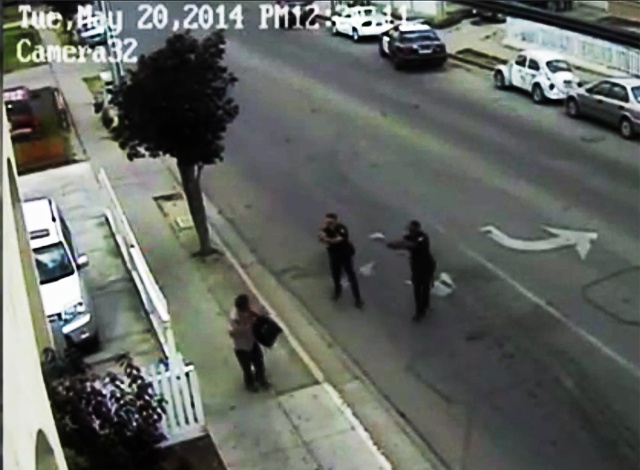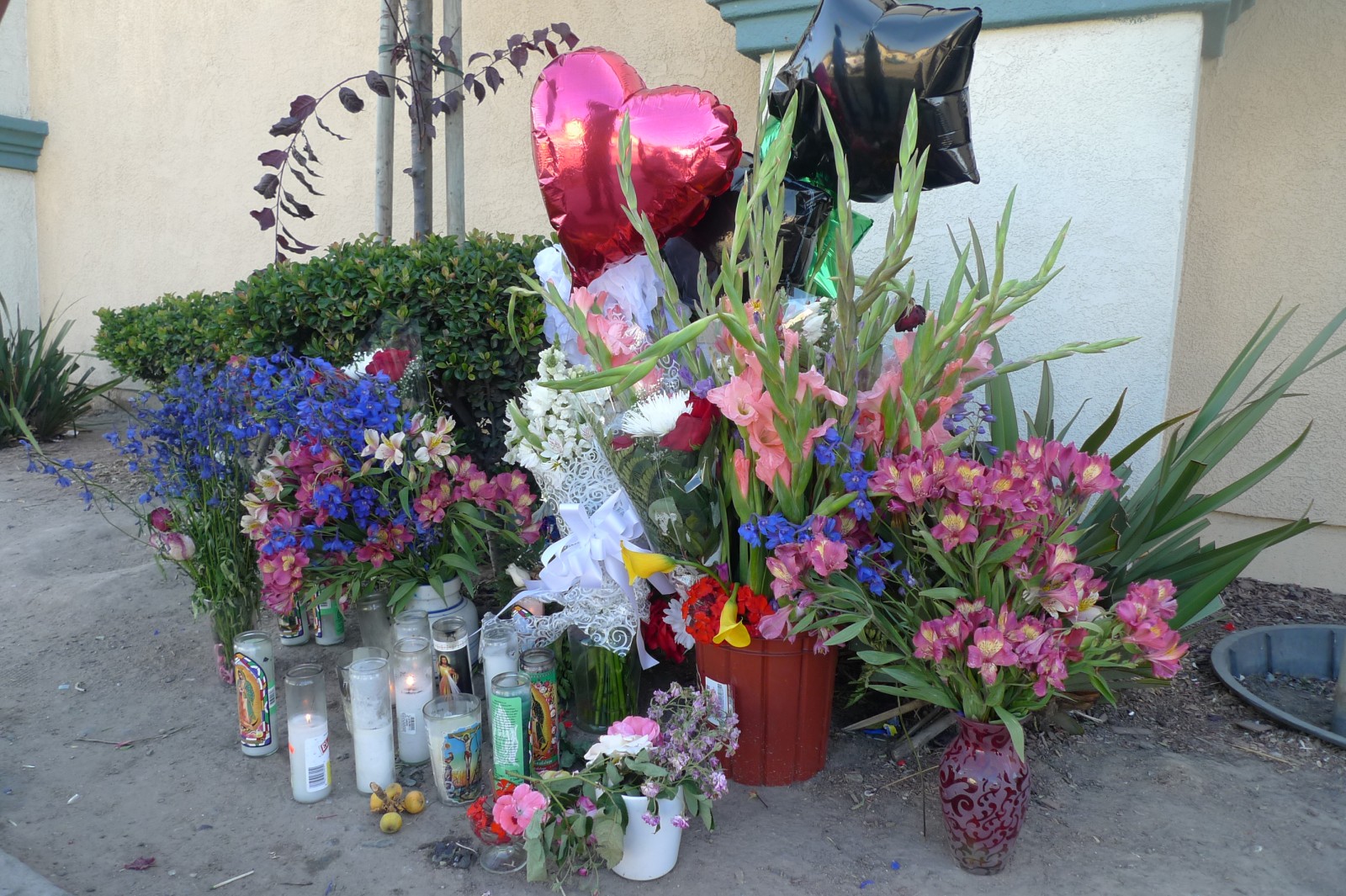SALINAS, Calif. – On May 20, Carlos Mejia was walking toward a bakery. A gardener and day laborer at construction jobs, Mejia was carrying two-foot garden shears. And he was trailed by two police officers.
A woman reported that he’d tried to break into her house with the shears, exposed himself and attacked her dog. When officers arrived, they told him to stop and drop the shears but instead he continued down the sidewalk, headed toward a busy intersection.
Seconds later, they fired at least five shots at Mejia at point-blank range.
The shooting death was caught on a cell phone and quickly went viral, getting more than 200,000 YouTube views within a week. Shocked onlookers can be heard rebuking the officers. The community was already reeling from a police shooting in March and another one just 11 days before the Mejia shooting.
As news of the latest incident spread, Shi Cota rushed to the scene. Cota, 38, has lived in Salinas her entire life, but she says the recent spate of police shootings has put her and many other residents in this largely Latino community on edge.
“Sometimes you fear gangs and crazy men,” Cota said, “but this case was the police … and what happens to our people when we see injustice like that … we don’t trust anymore and we get angry.”
Cota said Mejia’s body remained uncovered for hours. The next day, she returned to the same corner to stage a small, peaceful protest with her daughter and a few friends, all carrying “Honk for Justice” signs.
What started as a little protest grew to hundreds of people calling attention to the shootings – all of which involved Latino victims. It’s part of the decades-long battle for the soul of Salinas: What can a city to do help ease racial tensions between citizens and police?
A Public Relations War?
Police Chief Kelly McMillan has been fielding questions about the string of shootings – and battling misperceptions. McMillan told America Tonight that two Salinas police officers confronted Mejia, giving him commands in English and Spanish. As the officers followed him toward a more populated area, “he was refusing to comply with their commands,” McMillan said.
The officers deployed stun guns, but one malfunctioned and the other missed Mejia, the chief said.
McMillan told America Tonight a security camera video that his department released publicly shows that Mejia lunged at the officers before they shot him with their guns. Still, McMillan says this isn’t the first offensive in a public relations war.
“There’s a great deal of consternation in the public with the way the police conducted themselves,” McMillan told America Tonight. “Our intent in releasing that video is to more accurately inform the public of what Mr. Mejia was doing out there.”
Born With Social Injustice
Growing up in Salinas, Cota, a Latina, viewed police as the enemy.
“Their actions on us or our people and our community has always been like, you know, they racial profile, they arrest them, they have a bad perception,” she said.
Now, Cota is raising a family here, but she worries that young people, even her own kids, could be shot and killed by local police.
“It’s hard to have dialogue with two teenagers,” she said, crying. “I always try to keep them safe … just so they won’t be out there, or even profiled. They might get shot because they look a certain way, or if they’re on the wrong side of town, or because they have a hoodie, or because they have short hair, or because of the color of their skin.”
Professor William Arrocha of the Monterey Institute of International Studies said that there have long been tensions between workers and the business establishment here.
“Salinas is a city that was born with social injustice,” he said.
An agricultural mecca with a history of inequality, the Salinas Valley is where Caesar Chavez famously led the so-called Salad Bowl farm worker strikes. It’s also the birthplace of writer John Steinbeck, who set several of his novels about disempowered Americans here.
The valley generates $4 billion annually and produces most of the nation’s strawberries and artichokes, Arrocha said. Yet, he added, the majority of workers who till these fields are “extremely underpaid.”
“If Steinbeck was alive and he was writing ‘East of Eden,’ he would keep adding chapters,” Arrocha said. “Just like the migrants were suffering [then], they’re suffering now in Salinas.”
In some ways, he said that the same can be said of the Salinas police, a department that’s seen its budget slashed in recent years and now has a less than one police officer per 1,000 residents. According to Governing, American cities with more than 50,000 residents averaged nearly twice that in 2012.
“They’re trying to do their best to try to keep peace in the place where most of the violence is gang-related violence,” he said. “Gangs that are there because the youth in Salinas does not find dignity through jobs there they can serve the community.”
"We Have to Come Together"
The small protest Cota started the morning after Mejia’s death had become a huge event by that night. And then, yet another shooting. This time the victim was Constantino Garcia, a 23-year-old strawberry picker who had just moved to the area. McMillan says an unknown assailant shot Garcia before police even arrived. But the deep mistrust of police in Salinas made many protesters suspect officers played a role.
“What you heard in the crowd was the police did it again, the police killed somebody else,” Cota said.
McMillan described the climate following the shootings as emotional and “not rational.”
“I’m not taking away from anybody’s anger, anybody’s frustration, anyone’s fear or disgust of law enforcement,” McMillan said. “But we deal with facts and the facts of this investigation will be assembled in a report, it’ll be sent to the Monterey County District Attorney’s Office and they can decide if the officers were justified.” He added: “The conversation in the community is now: ‘How do we rebuild?’”
The city is trying to do just that. Last week, community members came together with city officials including Mayor Joe Gunter to address the ongoing criticism of the police.
“We’re really looking for answers on both sides, because I don’t think we hire policemen with the intent of them wanting to shoot somebody,” Gunter said. “But the good news is I think what we’re going to see is a coming together of the community – for an answer, for the solution and for the future.”
Even in this still-divided community, that sentiment is widespread.
“We can’t be fighting each other,” Cota said. “We have to come together and stop the violence.”
3 WAYS TO SHOW YOUR SUPPORT
- Log in to post comments

















